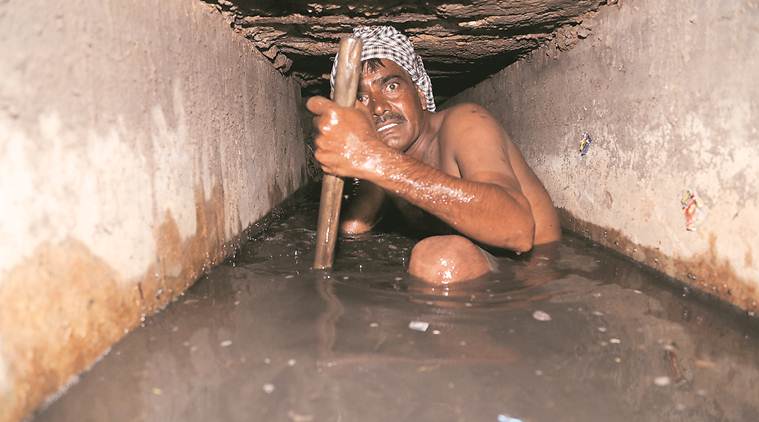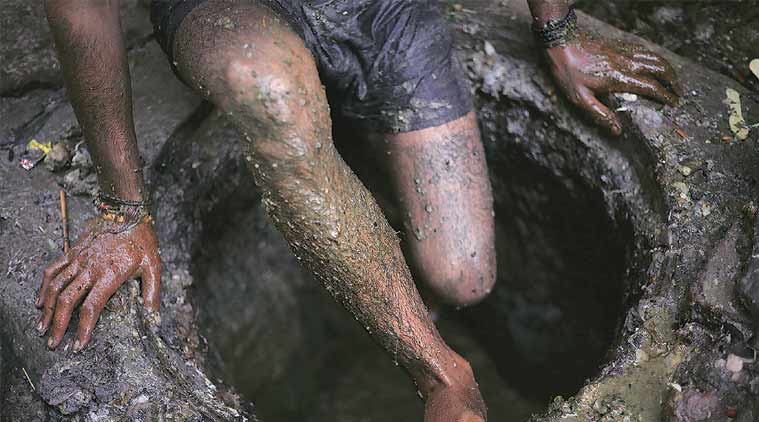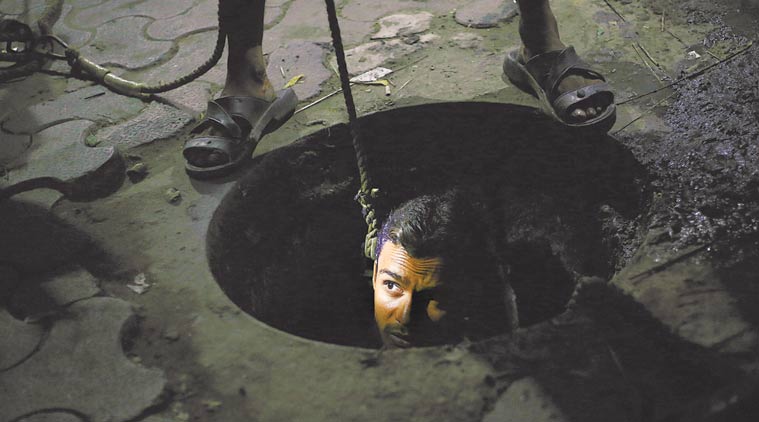”நம் நாட்டைப் பற்றி ஏன் லண்டனிலிருந்து வெளிவரும் ArtReview Asia பத்திரிகையில் எப்போதும் இழிவாகவே எழுதுகிறீர்கள்? நல்லதாக எழுத எதுவுமே இல்லையா?” என்று கேட்கும் நல்லிதயங்களுக்கு இந்தக் கட்டுரையை சமர்ப்பிக்கிறேன். அந்த நல்லிதயங்களிடம் நான் தெண்டனிட்டுக் கேட்டுக் கொள்வதெல்லாம் ஒரு ரெண்டு நிமிடம் செலவு செய்து இந்தக் கட்டுரையைப் படியுங்கள் என்பதுதான். இந்தக் கேடுகெட்ட துப்புக் கெட்ட நாட்டைப் பற்றி நான் எப்படி நல்லதாக எழுத முடியும்? உடம்பே புழுத்து நாறிக் கொண்டிருக்கும் போது ஒருத்தரின் மயிர் அலங்காரம் பற்றியா புகழ முடியும்? இன்னமும் மனிதர்கள் இந்த தேசத்தில் பாதாள சாக்கடையில் இறங்கித்தான் தன் கைகளால் சுத்தம் செய்கிறார்கள். அங்கே சேர்ந்துள்ள விஷவாயுவினால் தாக்கப்பட்டு சாகிறார்கள். குடித்து விட்டுத்தான் அந்த மலக்கிடங்குக்குள் இறங்க முடிகிறது. அந்தக் குடி உங்கள் குடும்பத்தை அழித்து விடும், குடிக்காதீர்கள் என்று நல்லவர்கள் வலியுறுத்துகிறார்கள். பால் பாட் போன்ற கம்யூனிஸ்டுகள் ஆட்சிக்கு வந்தால் அந்த நல்லவர்களைக் கம்பால் அடித்தே கொல்லுவார்கள். நல்லவர்களின் குடிக்காதே வன்முறைக்கு அதுதானே பதில்? அந்த பாதாள சாக்கடை அடிக்கடி அடைத்துக் கொள்ளும். காரணம், நவநாகரீகப் பெண்கள் சிலர் தங்கள் sanitary napkins-ஐக் கழிவறையில் போட்டு விடுகிறார்கள்; அல்லது பேப்பரில் மடித்து ரோட்டில் போட்டு விடுகிறார்கள். அந்த ரத்த வாடைக்காக காக்கா, பூனை, நாய்கள் எல்லாம் அதை இழுத்துக் கொண்டு போய் முகர்ந்து பார்த்து விட்டு சாக்கடையில் போட்டு விடுகின்றன.
பாதாள சாக்கடையை சுத்தம் செய்யும் தாழ்த்தப்பட்ட சாதியைச் சேர்ந்த தொழிலாளர்கள் அத்தனை பேரும் கடைந்தெடுத்த ஆணாதிக்கவாதிகள்தான். குடித்து விட்டு சாக்கடையில் இறங்கி சாக்கடையைச் சுத்தம் செய்து விட்டு வீட்டுக்குத் திரும்பும் போது மீண்டும் டாஸ்மாக்கில் குடித்து விட்டுப் போய் மனைவியை இழுத்துப் போட்டு அடிப்பவர்கள்தான். அவர்கள் சாக்கடையில் அடைத்துக் கொண்டு கிடக்கும் தூரத் துணியை வெளியே எடுத்துப் போடும் போது பெண் இனத்தைத் திட்டும் வார்த்தைகளை நீங்கள் கேட்க வேண்டும்…
இந்த நாட்டைப் பற்றி நான் சாகும் வரை திட்டிக் கொண்டே தான் இருப்பேன். என்றைக்கு பாதாள சாக்கடையில் மனிதன் இறங்காமல் எல்லாம் எந்திரமே செய்கிறதோ அன்றைக்குத்தான் நல்ல வார்த்தை எழுதுவேன். இன்றைக்கும் எத்தனையோ கிராமப்புறங்களில் மனிதப் பீயை கீழ்த்தட்டு மனிதர்கள்தான் சுத்தம் செய்கிறார்கள்; சுமக்கிறார்கள். வட இந்தியா முழுவதும் இதுதான் நடைமுறை. இது பற்றி எத்தனையோ ஆவணப்படங்கள் வந்து கொண்டிருக்கின்றன. மன்மோகன் சிங் பாராளுமன்றத்திலேயே பேசினார். manual scavengingஐ ஒழித்தே தீருவோம் என்று. சுதந்திரம் வாங்கி இத்தனை ஆண்டுகள் ஆகியும் இதுதான் நிலை.
நல்லவர்களே, இந்தக் கட்டுரையைப் படித்துப் பாருங்கள்.
courtesy: INDIAN EXPRESS
Written by Shalini Nair | New Delhi | Updated: September 18, 2018 9:12:55 am
X
Panel counted 123 deaths since January 1, 2017. (File Photo)
SINCE JANUARY 1, 2017, one person has died every five days, on an average, while cleaning sewers and septic tanks across the country, according to numbers collated by the National Commission for Safai Karamcharis (NCSK), the statutory body that was set up by an Act of Parliament for the welfare of sanitation workers.
The data, which is based mostly on newspaper reports and numbers supplied by a few state governments, is the first such official attempt to account for the deaths of sewer and septic tank cleaners.
According to NCSK, 123 people employed in hazardous forms of manual scavenging lost their lives while at work since January 2017. The last one week alone has seen a total of six deaths in the National Capital Region. Officials involved in the exercise admit, however, that even this number could be a gross under-estimation, considering the lack of data.
READ | 53,000 manual scavengers in 12 states, four-fold rise from last official count
There are no numbers available on those employed in sewer and septic tank cleaning. All previous and ongoing exercises at compiling data have been restricted to accounting for those removing human excreta from dry latrines, open drains, and single pit toilets in villages.
manual scavenging act, sewage cleaners death, sewage workers, manual scavengers, sewer deaths, sanitation workers, indian express According to NCSK, 123 people employed in hazardous forms of manual scavenging lost their lives while at work since January 2017. (Express Photo: Tashi Tobgyal/File)
The more hazardous forms involving the often fatal task of entering toxic sewerage systems, mainly in urban areas, have not been documented officially. This, despite the fact that the 1993 law outlawing manual scavenging in India was amended in 2013 to include sewer and septic tank cleaning.
ALSO READ | Swachh Bharat’s forgotten soldiers
Of the 28 states and seven union territories, the NCSK data has reported deaths from only 13 states and UTs.
“The death count is based on figures we could collate from a few states and mostly English and Hindi newspapers. There might have been several instances of similar stories in regional language papers which were weren’t able to account for,” said an official involved in the exercise.
This is evident in the reported instances which are high in in Haryana, Uttar Pradesh, Delhi, and Gujarat, in that order. On the other hand, the NCSK data shows Maharashtra as having had just two deaths in this period. As per the Socio-Economic Caste Census (SECC) 2011, rural Maharashtra alone has 65,181 households where at least one person is employed as a manual scavenger, the highest in the country, accounting for 35 per cent of the total 1.82 lakh such households in rural India.
SECC data doesn’t include urban India where sewer cleaning is more frequent. The state with the second highest number of manual scavenging in its villages — Madhya Pradesh at 23,105 as per SECC — doesn’t show any deaths in the NCSK data.
“We have repeatedly asked states to identity those involved in these jobs but the states deny the existence of manual scavenging as the practice is banned under law. As a result, in many cases, the families of the dead don’t even get the compensation,” said NCSK chairperson Manhar Valjibhai Zala.
As per NCSK data, the Rs 10 lakh compensation that is mandated under law in case of manual scavenging deaths, has been paid in only 70 of the 123 cases.
manual scavenging act, sewage cleaners death, sewage workers, manual scavengers, sewer deaths, sanitation workers, indian express Of the 28 states and seven union territories, the NCSK data has reported deaths from only 13 states and UTs. (Express Photo: Tashi Tobgyal/File)
The paucity of data is evident in the count of people involved in manual scavenging, an exercise being carried out by an inter-ministerial task force led by the Ministry of Social Justice and Empowerment. The count is limited to only 170 districts in 18 states. Again, it excludes sewer cleaners entirely as well as any form of manual scavenging in urban areas.
The counting process was to be carried out by central government teams holding survey camps in districts where those engaged in manual scavenging could come forward for a self-declaration process. Following this, the states were to confirm the numbers identified.
While the exercise was to be over by June-end, officials confirmed that it has been significantly delayed as central government teams and state governments have so far acknowledged the existence of only 20,000 out of around 50,000 people identified.
Data obtained by The Indian Express shows that only 109 of the 170 districts have filed their response, and only 62 have identified at least one manual scavenger.
manual scavenging act, sewage cleaners death, sewage workers, manual scavengers, sewer deaths, sanitation workers, indian express Data obtained shows that only 109 of the 170 districts have filed their response, and only 62 have identified at least one manual scavenger.
Bezwada Wilson, founder of Safai Karamchari Andolan (SKA), said that the central government has ignored repeated recommendations for extending the survey to include another 300 districts and sewer-septic tank cleaners. Wilson was part of the team that assisted the central government in carrying the recent survey in 170 districts.
“Their deaths are under-counted and so are their lives. Even the National Crime Records Bureau was agreeable to our suggestion that they should document the deaths separately. But nothing has happened on the front, either,” he said.
According to data and post-mortem reports maintained by the SKA, the actual death count since January 2017 is about 300.
“The Social Justice Ministry, which is in charge of this subject, mostly deals with the issue of compensation post deaths and rehabilitation of the handful identified as doing this job. Ministries such as Housing and Urban Affairs should be looking into the complete mechanisation of sewage cleaning, which is the only way to eliminate the practice of getting people to clean it manually. But they have never taken responsibility for the deaths,” Wilson said.


